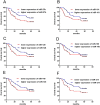Prognostic Value of microRNA Signature in Patients with Gastric Cancers
- PMID: 28202938
- PMCID: PMC5311868
- DOI: 10.1038/srep42806
Prognostic Value of microRNA Signature in Patients with Gastric Cancers
Abstract
The occurrence of lymph node metastases (LNM) after endoscopic submucosal dissection (ESD) in patients with gastric cancer (GC) leads to poor prognosis. However, few biomarkers are available to predict LNM in GC patients. Thus, we measured expression of 6 cancer-related miRNAs using real-time RT-PCR in 102 GC samples that were randomized into a training set and a testing set (each, 51 cases). Using logistic regression, we identified 4-miRNA (miR-27b, miR-128, miR-100 and miR-214) signatures for predicting LNM in GC patients. Patients with high-risk scores for the 4-miRNA signature tended to have higher LNM than those with low-risk scores. Meanwhile, the ROC curve of the 4-miRNA signature was better for predicting LNM in GC patients. In addition, Cox regression analysis indicated that a 2-miRNA signature (miR-27b and miR-214) or a miR-214/N stage signature was predictive of survival for GC patients. This work describes a previously unrecognized 4-miRNA signature involved in LNM and a 2-miRNA signature or miR-214/N stage signature related to GC patients' survival.
Conflict of interest statement
The authors declare no competing financial interests.
Figures






References
-
- Nakajima T. Gastric cancer treatment guidelines in Japan. Gastric Cancer. 5, 1–5 (2002). - PubMed
-
- Japanese Gastric Cancer, A. Japanese gastric cancer treatment guidelines 2010 (ver. 3). Gastric Cancer. 14, 113–123 (2011). - PubMed
-
- Abe S. et al.. A case of local recurrence and distant metastasis following curative endoscopic submucosal dissection of early gastric cancer. Gastric Cancer. 18, 188–192 (2015). - PubMed
-
- Fujii H. et al.. Lymph node metastasis after endoscopic submucosal dissection of a differentiated gastric cancer confined to the mucosa with an ulcer smaller than 30 mm. Dig Endosc. 27, 159–161 (2015). - PubMed
Publication types
MeSH terms
Substances
LinkOut - more resources
Full Text Sources
Other Literature Sources
Medical
Molecular Biology Databases
Miscellaneous

